Introduction
Navigating the world of coding requires more than just knowledge of programming languages; it demands the right tools to enhance efficiency and productivity. A code editor stands as a crucial asset in this journey, transforming the coding experience by providing features like syntax highlighting, code completion, and error detection. These functionalities not only streamline the coding process but also elevate the quality of software development.
From understanding the essentials of a code editor and its key features to exploring popular options tailored to different needs, this article delves into how the right code editor can revolutionize your development workflow. Embrace the power of advanced tools and AI-driven enhancements to achieve maximum productivity and propel your coding projects to new heights.
Understanding What a Code Editor Is
A programming text processor is a specialized tool created to improve the development experience for programmers. In contrast to typical text manipulation programs, programming interfaces come with tools that help in creating, troubleshooting, and handling scripts effectively. They support various programming languages, providing functionalities like syntax highlighting, code completion, and error detection. These features streamline the coding process and improve productivity. For example, the latest version of CodeSandbox's web platform combines elements of VS Code with its own productivity tools, offering a minimalistic yet powerful environment tailored for collaboration. This ongoing enhancement guarantees that programmers have access to a seamless and efficient coding experience, ultimately contributing to higher quality software development.
Key Features to Look for in a Code Editor
Choosing the appropriate text editor is essential for improving your productivity. Key features like code-completion systems, which offer suggestions in real-time, significantly streamline the coding process. AI pair-programming applications, like GitHub Copilot, have transformed productivity by creating entire segments of code and anticipating what programmers may input next. These tools aid creators of all skill levels, with junior individuals experiencing the largest productivity gains. By integrating AI suggestions, programmers can reduce cognitive load, improve product quality, and even enhance their coding enjoyment. Furthermore, the incorporation of chat-oriented programming helps developers understand codebases more effectively, reducing the time spent on reading documentation and tracing function calls. This holistic approach not only speeds up the programming process but also ensures a seamless workflow from issue comprehension to implementation.
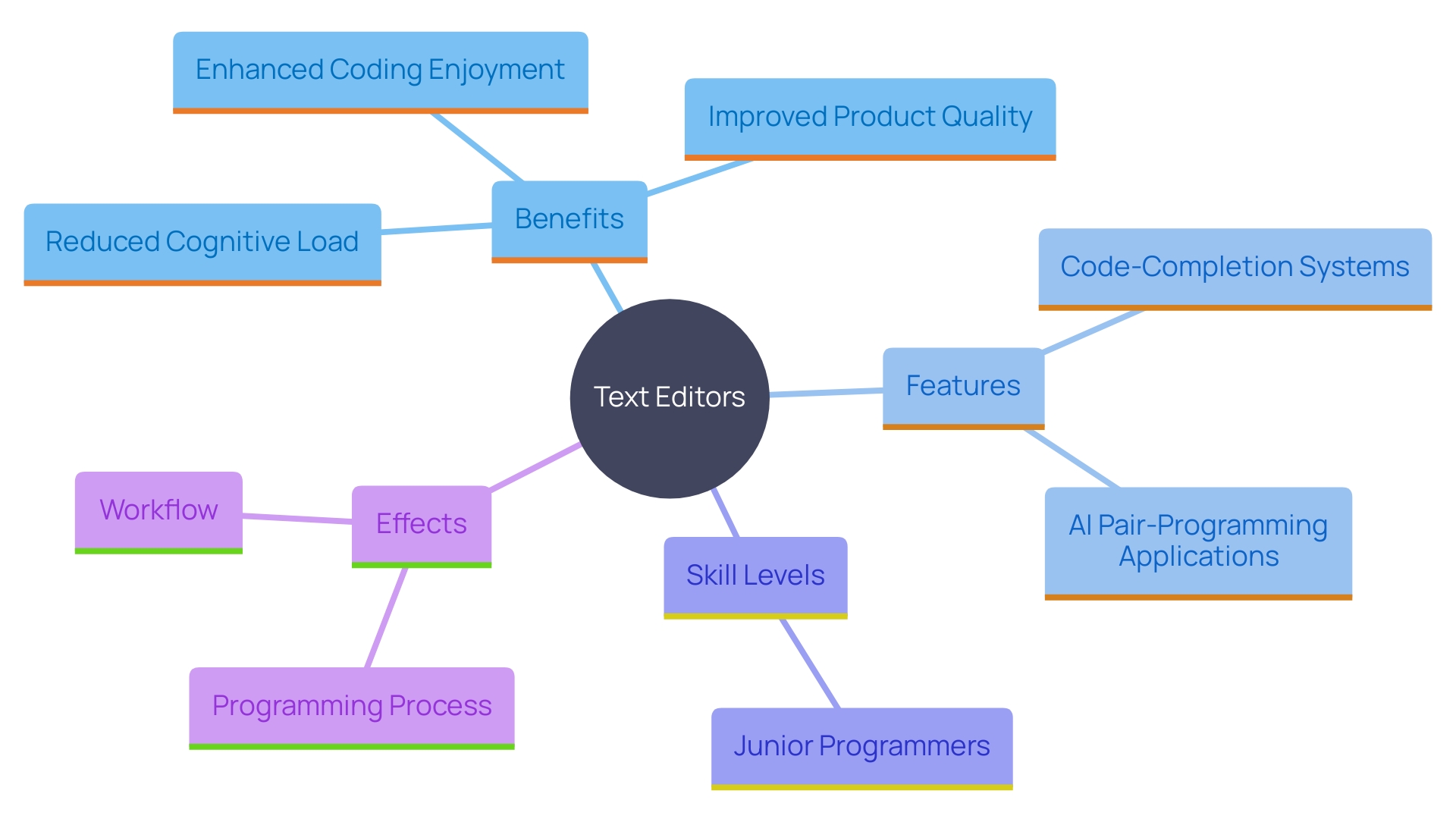
Syntax Highlighting
Syntax highlighting is a crucial aspect in programming editors, utilizing colors and fonts to distinguish different components of the script. This visual distinction significantly enhances program readability, aiding developers in understanding the structure and flow of their applications more intuitively. By promptly identifying mistakes, syntax highlighting not only simplifies the debugging process but also aids in maintaining clean and efficient programming. As noted in the evolution of programming languages, from the simplicity of Assembler to the complexity of contemporary object-oriented languages, the necessity for tools that enhance understanding has only grown. By making these intricate details of programming easily visible, syntax highlighting assists programmers in navigating and mastering sophisticated paradigms.
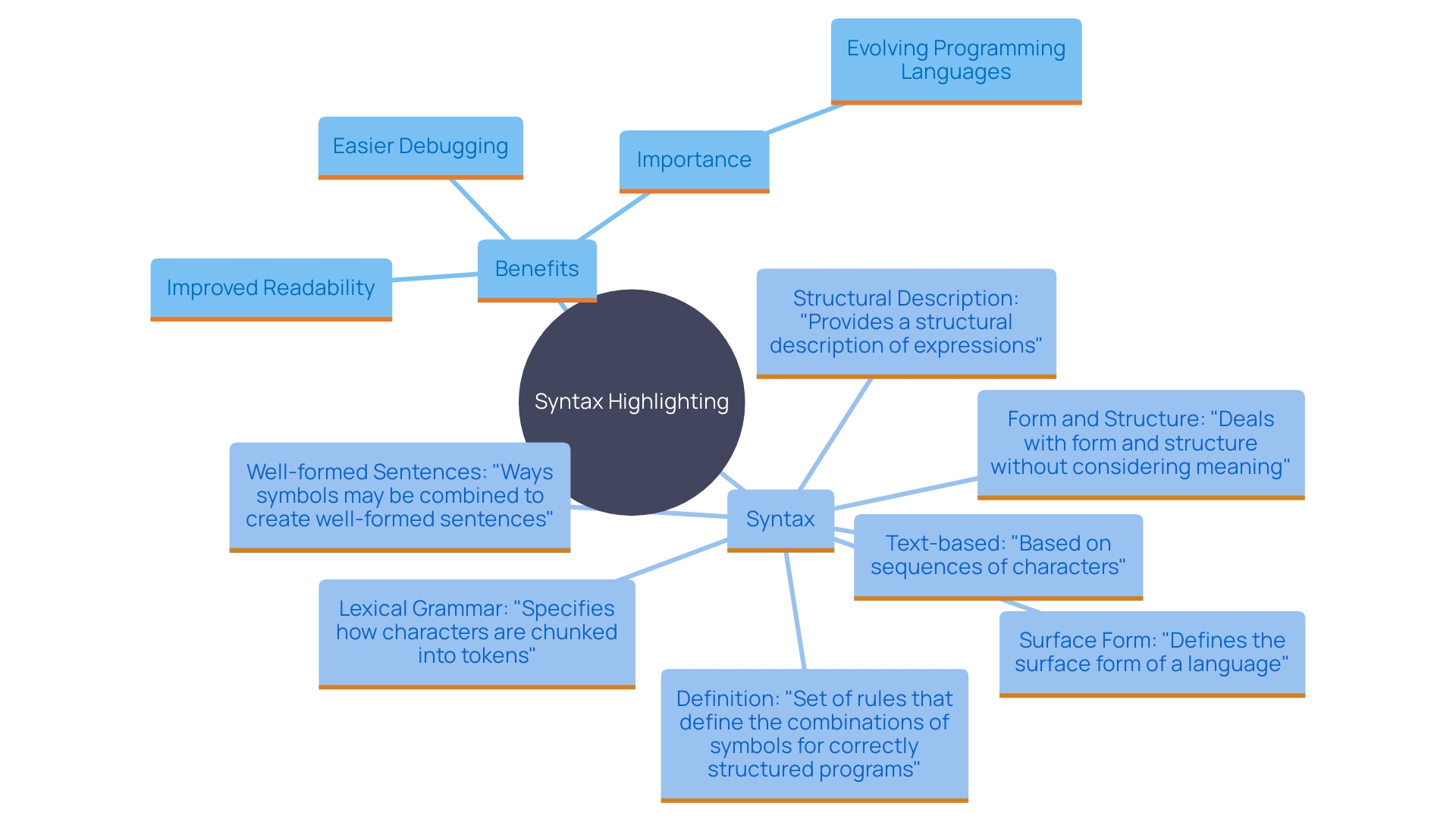
Code Completion and Auto-Completion
Code completion and auto-completion features have transformed the manner in which programmers write code by utilizing advanced AI algorithms. These resources, often incorporated within integrated development environments (IDEs), anticipate and propose relevant keywords, functions, and variables as programmers type, significantly improving coding speed and precision. For instance, GitHub Copilot, an AI pair-programming assistant, has shown significant enhancements in productivity for less experienced programmers. By offering real-time suggestions, these systems enable developers to concentrate more on the logic of their programming rather than syntax, ultimately decreasing cognitive load and enhancing enjoyment and learning.
A prime illustration is Google's internal programming completion resources, which utilize large language models (LLMs) to produce entire segments of programming based on the current context. These AI-driven suggestions can span multiple lines, offering completions at any position in the programming. The effect is evident: with an acceptance rate of 37%, these resources aid in the completion of 50% of character sequences, streamlining the development process and enhancing efficiency.
Furthermore, these AI-driven applications not only improve software quality but also change the programmer's position, converting them into evaluators instead of simple creators. This shift allows for a more efficient workflow, where the balance between review cost and added value is meticulously maintained. As AI technology continues to evolve, the integration of such advanced features into coding environments promises even greater efficiency and satisfaction for developers.
Error Checking and Linting
Error verification and linting utilities are essential for preserving high programming quality. These tools automatically scan your programming to identify potential errors and stylistic issues, providing real-time feedback that helps adhere to best practices. A notable example is Google's use of static analysis checkers like Error Prone, which are integrated into every build process to catch and resolve issues before submission of the program. This approach not only enhances code reliability but also improves performance efficiency. Furthermore, resources such as Luau's type system reduce false positives, allowing programmers to concentrate on real errors. By utilizing these resources, programmers can guarantee their codebase stays organized, comprehensible, and strong, ultimately promoting a more efficient and cooperative development atmosphere.
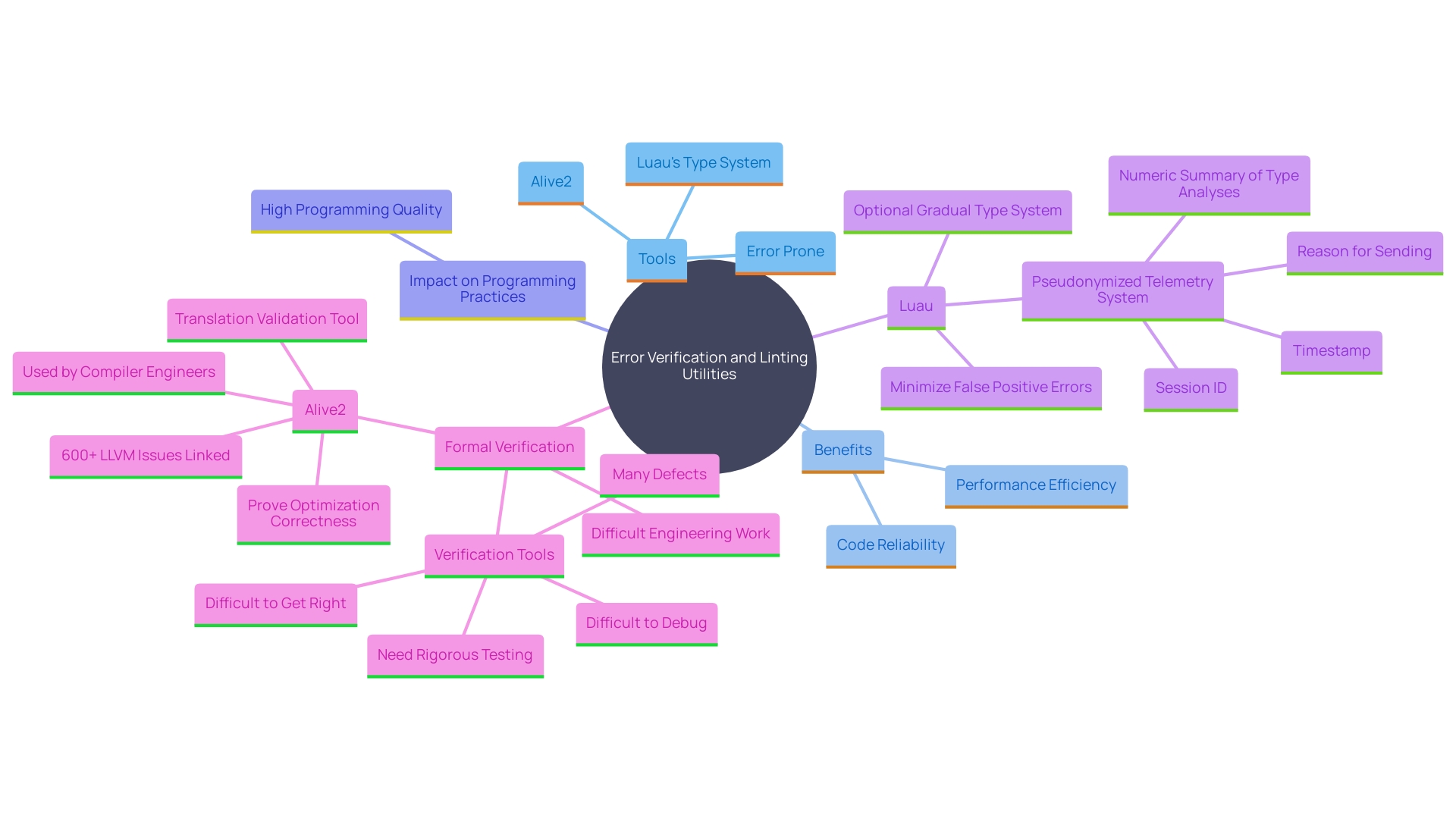
Navigation and File Management
Efficient navigation and file management capabilities in programming environments enable programmers to transition smoothly between files and swiftly find functions or variables. This capability is crucial in larger projects, significantly streamlining the coding process. For example, resources providing code-completion systems, like AI pair-programming applications such as GitHub Copilot, enhance productivity by offering suggestions and generating code snippets based on the context of what the programmer is working on. This not only reduces task time but also enhances product quality and overall enjoyment of the coding process. Moreover, these resources guarantee compliance with coding standards and best practices, preserving uniformity throughout the entire project, which is vital for effortless cooperation among team members. The use of unified work environments provided by CASE tools further reduces communication gaps and fosters a collaborative atmosphere, enabling programmers, designers, and testers to work cohesively. Moreover, version control and tracking features aid in effective management of modifications made by various team members, thereby improving project efficiency and alleviating cognitive burden on programmers.
Customization and Extensibility
A robust program editor must provide extensive customization options and support for extensions or plugins, allowing developers to tailor the editor to their unique workflows. This flexibility is essential for incorporating extra resources that improve functionality and simplify development processes. For example, the CodeSnapshot plugin provides an efficient method to share snippets during presentations, demonstrating the practical benefits of customization.
'AI pair-programming tools like GitHub Copilot considerably boost productivity for programmers by offering code suggestions that can span multiple lines.'. This feature is particularly beneficial for junior programmers, who see the largest gains in task time, product quality, cognitive load, enjoyment, and learning.
Furthermore, Visual Studio's extensibility model serves as a prime example of how a program can accommodate various customization needs. Developers can create commands, manipulate file contents, and manage in-memory document representations, showcasing the diverse possibilities that extensions and plugins can provide.
Statistics reveal that 77% of programmers utilize AI tools such as ChatGPT, and 46% employ GitHub Copilot, highlighting the significance of possessing a customizable programming interface that can incorporate these advanced tools. By supporting extensions and plugins, programming tools not only boost productivity but also adjust to the evolving requirements of programmers in a constantly shifting technology environment.
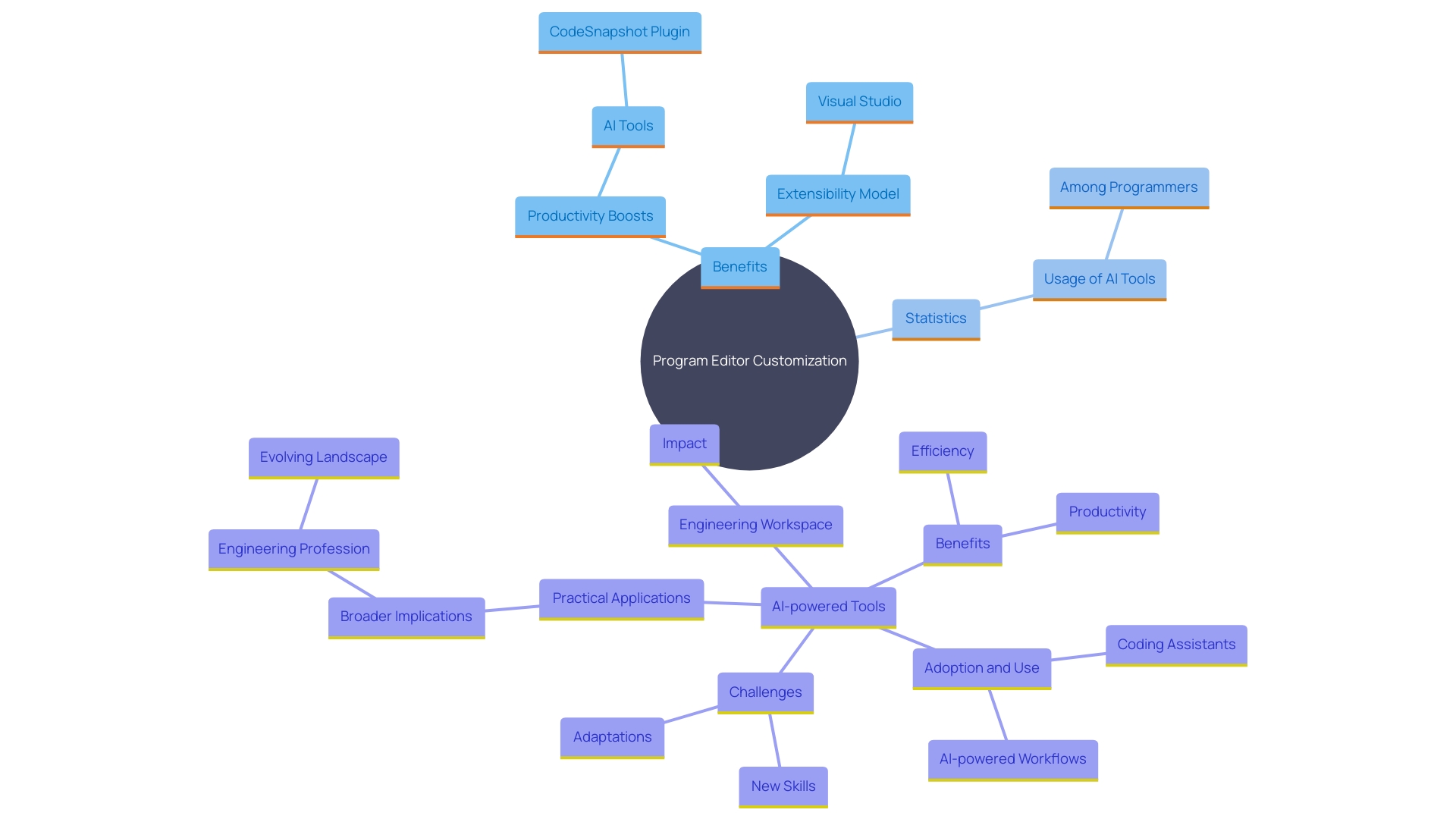
Version Control Integration
Incorporating version control systems such as Git directly into the programming environment transforms management of software. This integration facilitates seamless tracking of changes, enhances collaboration among programmers, and effectively manages project history. As source script management becomes increasingly vital in a fast-paced development environment, embedding these systems within the editor ensures agility, scalability, and performance. By allowing programmers to contextualize modifications, comprehend needs, and collect pertinent information more efficiently, these integrated systems simplify the development process. Furthermore, leveraging AI tools for program generation within version control environments can drastically improve productivity, with lints and language servers enhancing accuracy and usability. This comprehensive method to version management within the interface not only streamlines the coding process but also accommodates all programming languages by default, making it a flexible option for programmers.
Popular Code Editors for Different Needs
Choosing the perfect code tool can dramatically improve your coding efficiency and overall experience. With a plethora of options available, each comes with unique features tailored to different needs. For instance, Visual Studio Code now boasts floating writing windows and JavaScript heap snapshot visualizations, making it a powerful choice for many developers. However, the optimal configuration of a coding editor can be challenging. Too few features mean missing out on efficiency gains, while too many can lead to slow performance and distraction. AI coding assistants, such as GitHub's Copilot, are revolutionizing the field by integrating necessary information right beside the code, thus maintaining workflow continuity and reducing interruptions. The rapid adoption of these AI tools underscores their transformative impact, promising a future where coding is even more streamlined and intuitive.
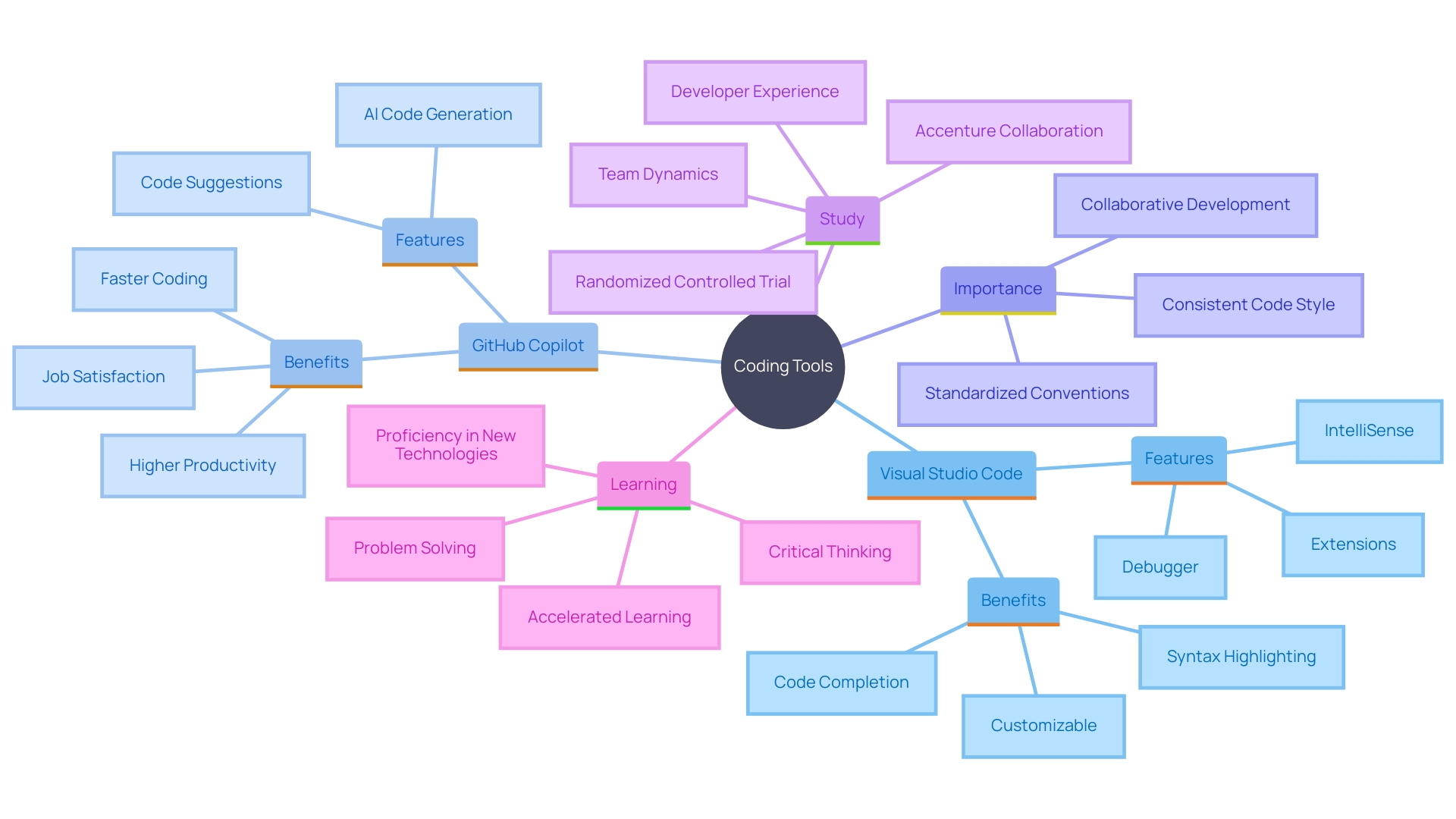
Visual Studio Code: A Free and Extensible Editor
Visual Studio Code, renowned for its versatility and extensive feature set, is a favorite among developers worldwide. With support for numerous programming languages and seamless Git integration, it's a powerhouse for coding efficiency. The Visual Studio Code marketplace offers thousands of extensions, most of which are free, designed to boost productivity and automate repetitive tasks. For instance, the Prettier extension ensures consistent formatting, which is crucial in collaborative projects. IntelliCode, another standout feature, uses AI to provide smart code completions based on thousands of popular open-source projects, making coding faster and more accurate.
A recent randomized controlled trial by Accenture emphasized the effect of such instruments in real-world settings. Developers using advanced coding assistants like GitHub Copilot experienced significant improvements in productivity and coding quality. This aligns with the broader trend of AI in software development, as evidenced by the 2023 Developer Ecosystem Survey, which gathered insights from over 26,000 developers globally. The survey revealed that AI-driven solutions are increasingly integral to modern development practices, driving efficiency and innovation.
Moreover, the latest release of Visual Studio 17.9 emphasizes the importance of user feedback in enhancing these tools. The Visual Studio team actively seeks suggestions and reports from users to continuously improve the IDE, ensuring it remains at the forefront of development technology. This collaborative approach not only refines the toolset but also fosters a community-driven evolution of the coding environment.
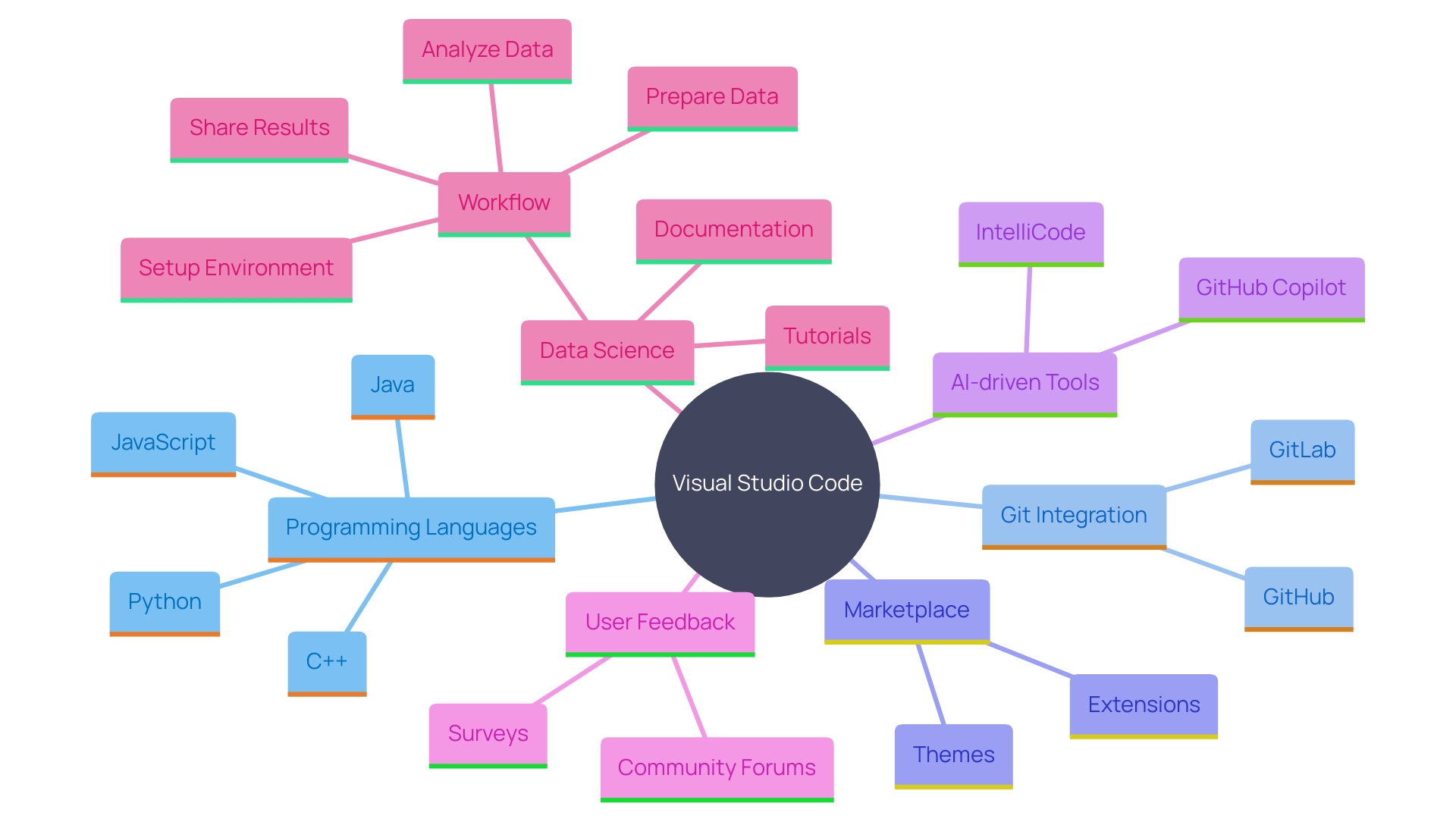
Sublime Text: A Powerful Editor for Efficient Coding
Sublime Text is notable for its remarkable speed and responsiveness, making it a preferred option for many programmers. Its clean interface, combined with powerful features like multiple selections and distraction-free mode, fosters a highly efficient coding environment. Notably, Sublime Text's companion app, Sublime Merge, extends this efficiency to version control, offering a seamless experience for managing project repositories. 'Despite the evolution of complex web development frameworks, Sublime Text remains a cherished application for its minimalist approach to text editing, allowing developers to concentrate on writing without unnecessary distractions.'. This efficiency in design aligns with the broader industry trend of leveraging tools that enhance productivity, such as AI-powered programming assistants that streamline repetitive tasks and improve quality.
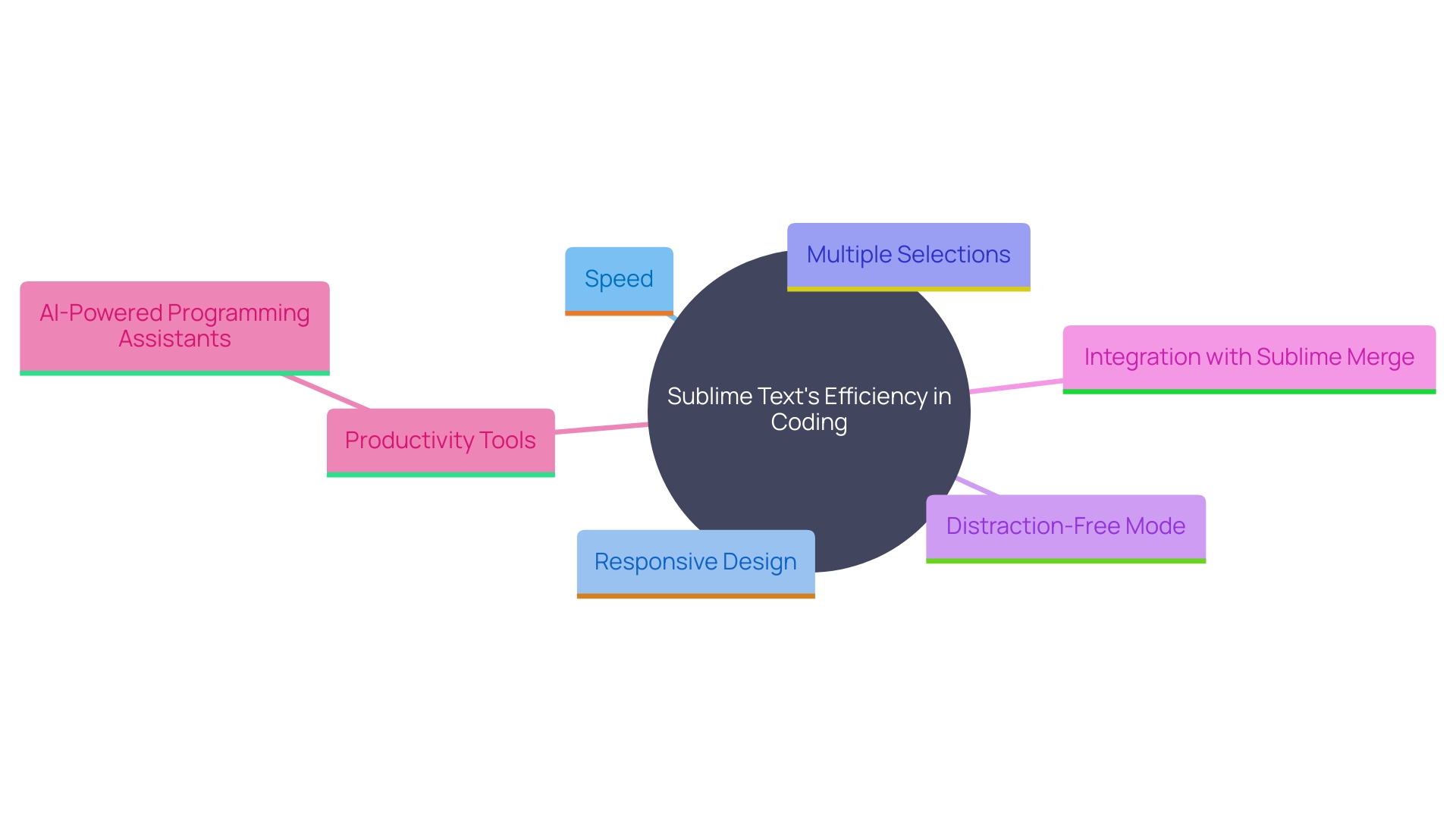
Atom: A Customizable and User-Friendly Editor
Atom is an open-source text manipulation tool renowned for its extensive customization capabilities and collaborative features. Its user-friendly interface is paired with a powerful package manager, allowing users to tailor the editor to their specific needs. 'This degree of customization is enhanced by sophisticated instruments such as code-completion systems, which anticipate and recommend snippets based on the present context, greatly improving programmer efficiency.'. AI pair-programming applications, such as GitHub Copilot, further enhance this by providing intelligent code recommendations, benefiting programmers of all skill levels. The continuous updates and community-driven enhancements in Atom ensure that it remains a cutting-edge tool for programmers seeking efficiency and innovation.
Vim: A Classic Editor for Advanced Users
Vim stands out as a highly configurable text tool, particularly favored by seasoned developers. This tool functions on a mode-based system, providing distinct modes for various tasks, which significantly enhances efficiency once mastered. The four primary modes to be familiar with are Normal Mode, Insert Mode, Visual Mode, and Command Mode. Normal Mode is the default when you open Vim, allowing you to navigate and edit the text. Insert Mode lets you input text, accessible by pressing 'i' from Normal Mode. Visual Mode is used for text selection, though it may not be as critical as often suggested. Command Mode enables various commands for manipulating text.
The learning curve for Vim might be steep due to its keyboard-centric approach, but the benefits are substantial. 'Modal editing enables quicker and more accurate actions within the interface, making intricate tasks feasible with just a few keystrokes.'. Moreover, Vim's customizability means you can tailor it to your specific workflow, ensuring maximum productivity. As one user aptly put it, 'Vim has lots of useful features that it would be impossible to cover in a single post.' This flexibility and efficiency make Vim an essential resource for those willing to invest the time to master it.

Notepad++: A Lightweight and Feature-Packed Editor
Notepad++ is a lightweight yet powerful programming tool renowned for its simplicity, speed, and robust feature set. As a free and open-source project, it has garnered a dedicated community of contributors who continuously enhance its capabilities. Notepad++ supports multiple programming languages and offers advanced features like multi-edit and the ability to remember inaccessible files across sessions. This makes it an ideal tool for quick edits and small projects. Additionally, users can enjoy features such as tabbed editing, find and replace functions, and dark mode, which further enhance productivity and user experience.
Choosing the Right Editor for Your Needs
Choosing the right code tool is essential for boosting your productivity and overall coding experience. Consider factors such as language support, required features, and how well the tool integrates with your workflow. The appropriate tool can significantly enhance your efficiency by providing customized features that suit your needs.
Numerous programming tools are lightweight and swift, providing a minimalistic user interface that streamlines the development process. For example, most programming tools are open source and free to use, making them an accessible choice for developers of all levels. However, the customization process can be time-consuming as finding the right extensions and making them work together seamlessly often requires considerable effort.
With strong communities surrounding these resources, there are usually excellent solutions to enhance the editors with new features. This extensibility can be a double-edged sword; while it allows for a highly customized environment, it can also lead to extension fatigue. Managing a large number of extensions can become cumbersome, requiring ongoing maintenance and updates.
'AI pair-programming applications such as GitHub Copilot have transformed the development process by providing real-time programming suggestions.'. These resources utilize large language models to foresee and create code snippets based on the context of your current work. Individuals of all skill levels report productivity gains, with junior team members experiencing the largest improvements.
Statistics from the 2023 Developer Ecosystem Survey, which included insights from over 26,000 developers, highlight the diverse use cases of programming languages and tools. Python, for example, is widely used for data analysis (47%), machine learning (42%), and web development (40%). This highlights the significance of selecting a programming tool that accommodates the languages and workflows pertinent to your projects.
In summary, selecting the right code editor involves balancing simplicity, customization, and community support to create an efficient and productive coding environment.
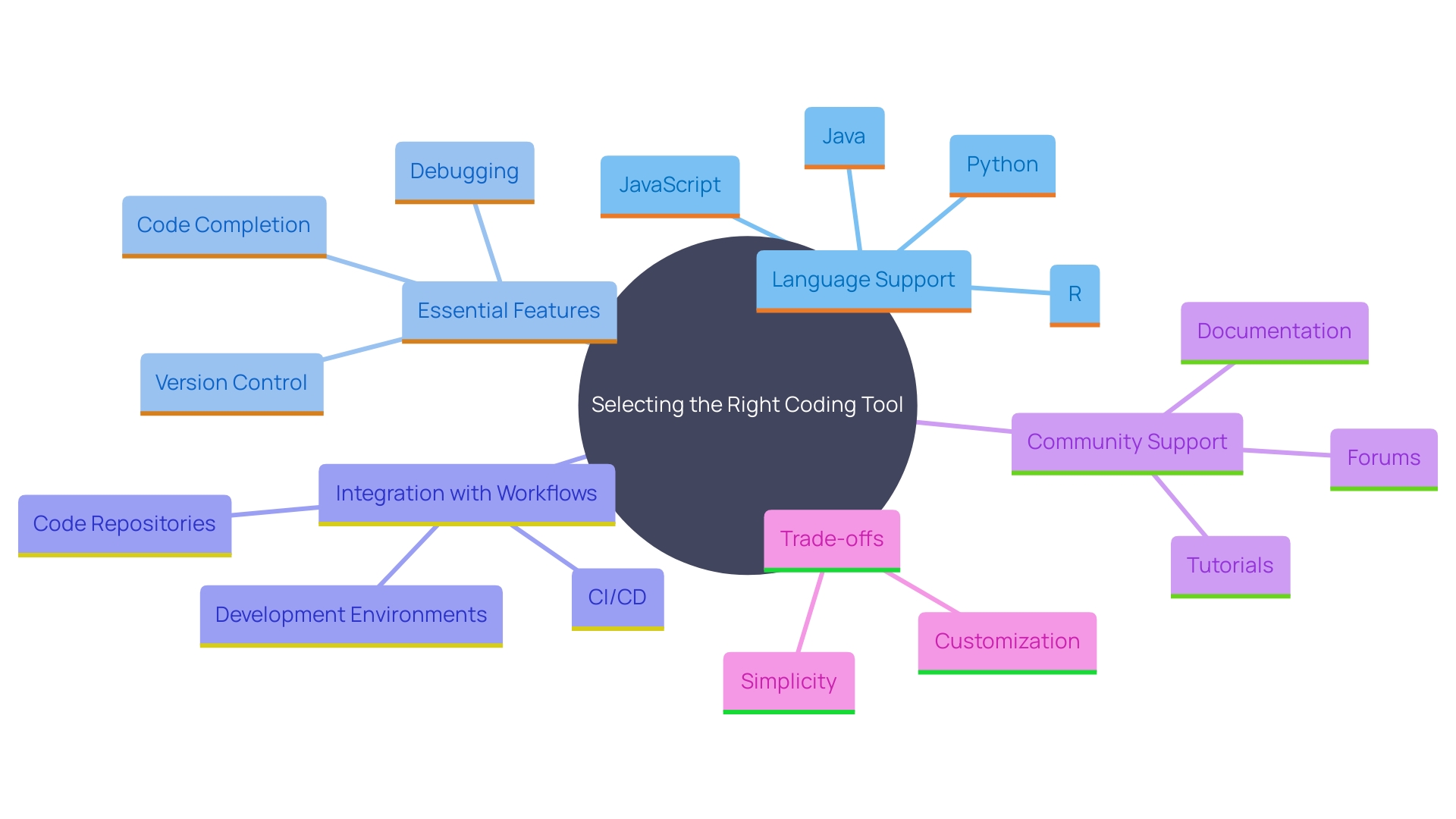
Conclusion
The exploration of code editors reveals their pivotal role in enhancing the coding experience and overall productivity for developers. By providing specialized features such as syntax highlighting, code completion, and error checking, these tools streamline the coding process, allowing developers to focus on logic rather than syntax. The integration of AI-driven tools like GitHub Copilot further revolutionizes this landscape by offering real-time suggestions, thereby reducing cognitive load and improving coding enjoyment.
Key functionalities such as effective navigation, file management, and version control integration enhance collaboration and streamline workflows, particularly in larger projects. Customization options allow developers to tailor their environments to their unique needs, ensuring that their coding experience is both efficient and enjoyable. Popular editors like Visual Studio Code, Sublime Text, and Atom each offer distinct advantages that cater to various preferences, ultimately reinforcing the importance of selecting the right tool for specific coding tasks.
In conclusion, the right code editor is more than just a tool; it is an essential asset that can significantly impact productivity and the quality of software development. By embracing advanced features and AI enhancements, developers can unlock their full potential, leading to a more seamless, efficient, and enjoyable coding journey.
Frequently Asked Questions
What is a programming text processor?
A programming text processor is a specialized tool designed to enhance the development experience for programmers. Unlike standard text manipulation programs, these processors offer tools for creating, troubleshooting, and managing scripts across various programming languages.
What features do programming text processors typically include?
They often include functionalities such as syntax highlighting, code completion, and error detection, which help streamline the coding process and improve productivity.
Can you give an example of a modern programming text processor?
The latest version of CodeSandbox's web platform combines elements of VS Code with its own productivity tools to create a minimalistic yet powerful environment designed for collaboration.
How does code completion enhance productivity?
Code completion features provide real-time suggestions for keywords, functions, and variables, allowing programmers to focus more on logic rather than syntax, which ultimately reduces cognitive load and enhances enjoyment.
What is syntax highlighting, and why is it important?
Syntax highlighting utilizes colors and fonts to differentiate components of a script, significantly improving readability and aiding in debugging by allowing developers to quickly spot mistakes.
How do error verification and linting utilities contribute to software quality?
These tools automatically scan code for potential errors and stylistic issues, providing real-time feedback to help maintain best practices, enhance code reliability, and improve performance efficiency.
Why is efficient navigation and file management crucial in programming environments?
Effective navigation capabilities allow programmers to transition smoothly between files and quickly locate functions or variables, which is essential for managing larger projects and enhancing overall coding efficiency.
What role do customization options play in programming editors?
Customization options allow developers to tailor the editor to their unique workflows, integrating additional resources that can improve functionality and simplify development processes.
How does the integration of version control systems improve project management?
Integrating version control systems like Git into programming environments allows for seamless tracking of changes, enhancing collaboration and effectively managing project history.
What are some popular programming text processors?
Some notable options include Visual Studio Code, Sublime Text, Atom, and Vim, each offering unique features and benefits tailored to different programming needs.
What impact do AI tools like GitHub Copilot have on programming?
AI tools like GitHub Copilot provide real-time programming suggestions, significantly boosting productivity, especially for less experienced programmers, by allowing them to focus on coding logic rather than syntax.
What factors should be considered when choosing a programming tool?
When selecting a programming tool, consider language support, required features, integration with your workflow, and the balance between simplicity and customization to create an efficient coding environment.




